PRODUCT REVIEWS
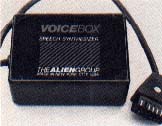
VOICE BOX II
The ALIEN Group
27 West 23rd St.
New York City, NY 10010
(212) 741-1770
$169.00, 32K – hardware & disks
Reviewed by Annie Cates
Talking computers, long a presence in science fiction, are now a reality. You can even have one in your own home. Your ATARI computer can sing, talk and curse at you while displaying the face of a customized computer personality on the screen. You can, indeed, even display graphics and animation or text (in any mode) while the Voice Box II talks.
You don’t need to be artistic to create a talking face. Voice Box II comes with a face that you can alter to create the perfect persona. While you graphically edit one half of the face, the other half follows the changes and creates a mirror-image likeness. While this limits your ability to create some effects, it certainly saves a lot of time. The lips of your computer face can be synchronized to match the speech or song that you direct it to vocalize. This really helps to create a personality!
If you want to create talking games, you will find instructions that will lead you through the steps necessary to incorporate the voice into the game program. The Voice Box II also comes with a disk that contains five games. You can play a talking version of the well known "Concentration" game, Stud Poker, Spelling, Acey Deucey, or Green Goblins. Jerry White’s Stud Poker game is similar to his Poker SAM from Don’t Ask. The real gem on this disk is a spelling program written by Ron Kramer. The words are tough – even for adults! Your computer will pronounce the word and ask you to type it on the keyboard. If you spell it incorrectly, you are asked to try again. When you spell it right you are congratulated!
The Voice’s speed and frequency are controlled through numbers in the string for vocal output. You can spell phonetically, or in plain English text. The voice is somewhat more difficult to understand than S.A.M. (a software speech synthesizer that disables the ANTIC chip and blanks the screen when it talks), yet it is quite intelligible.
Voice Box II makes a most intriguing addition to any computer. Possibilities with this tool are limitless. You could use this program to wake you up in the morning, alert you to intruders in your home, dial for help in an emergency, or any other thing that catches your fancy. It does take advanced computer knowledge to put those last ideas into practice. However, acquiring that knowledge is half the fun.
The games included with this hardware did not make imaginative use
of the voice, (very repetitive) but they did a nice job of demonstrating
what could be done!
AT-88 S-I DISK DRIVE
Percom Data Company
11220 Pagemill Road
Dallas, TX 75243
(800) 527-1222
$488.00 (first drive)
Reviewed by Richard DeVore
The Percom AT-88 S-1 disk drive is a less expensive alternative to the Atari 810 Disk Drive. With a list price of $488.00, it is more than $100.00 less than the 810. But saving money is not the only reason to consider the AT-88 S-1. It also performs as well as, if not better than, the Atari device.
The AT-88 S-1 is a forty-track, single-density, first drive system. It consists of a single-head drive with the power supply and controller mounted vertically in a single cabinet. The drive takes up slightly more than one half the shelf space required by the 810 – a significant savings. And, since the AT-88 is designed to be a first drive, it comes with a cable to connect it to the computer.
As is the case with many of the peripherals for the ATARI computer, the AT-88 connects in daisy-chain fashion. This allows it to function with virtually any equipment configuration.
A second version of the AT-88 is available without the controller. The AT-88 A-1 slave unit connects with the AT-88 S-1 via a cable. Up to three slaves can be controlled by a single S-1. The AT-88 drive has a single rocker switch in back that controls the on/off function. Also located at the rear of the unit, but in its top left corner (with the drive facing you), is an extender board with six blue jumper straps and a terminal DIP. These are used to prepare the drive for the particular equipment configuration you need.
An explanation of how to prepare the extender board is included in one of the best owner’s manuals I have ever seen. It is divided into five sections, which include an introduction, a discussion of the unit’s twelve possible configurations, and a guide to setting up the configuration you want. The manual also details the proper way to check the system, and concludes by explaining what to do if you have any problems with the unit.
Also included with the AT-88 is a copy of Optimised Systems Software’s
OSA + Version 2.0 operating system. This OS is compatible with most
software written for the ATARI. I’ve tested this system’s various
capabilities extensively, and in every instance programs have loaded and
run properly. I’ve found the AT-88 to be an excellent product, and
I recommend it highly.
THE DRUMESISER
Gemini Software/
Sar-An Computer Products
12 Scamridge Curve
Buffalo, NY 14221
(716) 632-3441
$49.95, 16K – Cartridge
Reviewed by George Joel
The Drumesiser will greatly interest musicians and other experimenters with sound. Sixteen different instruments, or sounds, can be created and played via the keyboard or through the joystick ports. With this cartridge inserted in an ATARI 800 and the audio output connected to an amplifier and speakers, the computer becomes a respectable live-performance instrument.
Drumesiser’s Editor lets you tune each instrument, if you desire. You can set such parameters as pitch, distortion, sustain (fine and coarse), and decay (fine and coarse). Possible sounds are piano, organ, harpsichord, and electric synthesizer. For the ambitious sound enthusiast, the CONTROL setting lets you set the AUDCTL register for each instrument. This is a memory register that gives you a high degree of specialized control over the sound produced by the POKEY chip in your ATARI. See Chabris’ "Sound Beyond SOUND," this issue, for more details.
You can also determine which pair (for fast repetition) of keys activates each instrument, or use the PORT feature. This option uses all four joystick ports for inputs, one instrument being activated by each of four positions of each joystick. Of course, any type of input device can be used, providing it sends the proper signals. You can use default settings, in which case different drum sounds will be produced. The program offers fairly convincing imitations of snare drums, cymbals, high hats, tom-toms, hand clap, cow bell and triangle. The base drum sound is a little weak – understandable, given the hardware’s limitations.
You can record in your computer’s memory. Systems with 16K will record for 30 seconds, 32K will record for about two minutes, and 48K will record for about three minutes. On playback, you can set the speed anywhere from triple-time to v-e-r-y slow. You can save or load all instrument settings with disk or cassette. If you like, you may also save a recorded tune.
Having this program gave me the impetus, finally, to hook up the audio
output from my 800 to the stereo. (See "Ultra Sound," ANTIC, V.1,
No. 6 for instructions.) It was well worth the effort. Drumesiser
provides a useful tool for the truly creative person who wishes to get
the most out of his or her computer.
MPP-1100 PARALLEL PRINTER
INTERFACE
Microbits Peripheral Products
434 W. First
St. Albany, OR 97321
(503) 967-9075
$99.95, 16K – hardware
Reviewed by F. Neil Simms
For those of you who are reluctant to shell out the $200 or so to purchase an Atari 850 Interface Module, necessary to drive a parallel printer, this is the product you’ve been holding out for. The MPP-1100 is a parallel printer interface that connects to joystick Port Three and any printer using the 36-pin Centronics connector. The cable and connector are included, saving you the $30 – $40 cost of purchasing them separately. An adapter is available for 40-pin card-edge applications, including the Atari 825 and Centronics 737 printers.
The interface package includes a replacement ROM that must be installed in place of the existing Operating System ROM (CO12499) containing the printer handler routines. For this modified chip to operate properly, you must also install the Revision B upgrade ROM if you own an older ATARI with the original version. This chip is also available from MPP. To determine which version you have, type ? PEEK(58383) with the BASIC cartridge in place. If the computer returns a ’0,’ you have Revision B.
These two chips are located on the OS card in the ATARI 800, and on the mother board in the ATARI 400. Installation on the 800 is therefore quite simple: remove the top cover, extract the card and remove the case. Then take out the old chip or chips and insert the new one(s). The 400 is a bit more complicated, as the mother board is enclosed deep within the innards of the machine. However, if the simple, illustrated instructions are carefully followed, anyone with a Phillips-head and a flat-blade screwdriver should be able to complete the job in 15 minutes. If you feel uneasy about going inside the case, have a friend with some electronics experience lend you a hand. Please note, though, that on either machine installation of these chips will void your warranty. The interface package itself is covered for two years.
Connected between my 800 and Gemini 10 printer, the unit has performed flawlessly during several months of heavy use. It has proven to be compatible with all the software that I own; it should work just fine with any application that invokes the printer handler in a legal manner.
This interface is ideal for those who have no use for all those ports
on the 850 and who are interested in saving some money.
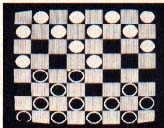
CHECKERS
Odesta Software
930 Pitner
Evanston, IL 60202
(312) 328-7101
$49.95, 32K – Disk
Reviewed by Arthur Leyenberger
Occasionally I come across a piece of software that is very well done. Although I am not a checkers expert, it is clear to me that this program is a quality product. Not merely a computer game, Checkers, by David Slate, should be thought of as a computerized game. Here’s why.
Options include: playing the computer at any of 16 skill levels; using the computer screen to let two people play against each other; asking the computer for advice on your move at any time; having the computer display an instant replay of the entire game ("movie mode"); setting up board positions and continuing play from there; and best of all, watching the computer play itself from either a predefined board position or the beginning.
Space does not permit a description of all of the features of Checkers.
Instead, I will present a typical game scenario. After booting the
game disk, you are presented with several choices. Your pieces are
controlled via a paddle or the left/right cursor control keys on the keyboard.
Aside from moving the players’ pieces, all commands are entered via the
keyboard.
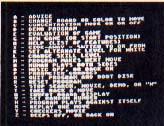
Next you choose to play either white or black pieces. Black always moves first and is the default selection. The player then chooses a difficulty level (skill level) from 0 to 15. The difficulty level determines the amount of time the computer spends "searching" for its move. At any time the STOP command will cause the computer to stop its search and play its best move so far.
Moves are checked for legality. Improper entries are indicated by an audible sound and ignored. In the higher levels, a computer move may take considerable time. A special feature available only on the Atari version of Checkers allows you to blank the screen during the computer’s "thinking time," speeding up the process by about 30 percent. Up to 30 moves may be taken back at any point in the game.
At the conclusion of the game, you may start a new game, take back the last few moves, or view the Checkers "movie." The "movie" is a rapid replay of the entire game.
Checkers is an excellent piece of software, from its well written and
complete manual (it even gives the history of the game) to its quality
packaging. There are so many features and variations to this game
that it will satisfy both the casual and the professional checkers player.
To summarize, Checkers is the definitive "computer" game. Although
it costs slightly more than a typical shoot ’em up, it is a quality product
and should be purchased by anyone who wants to see an excellent example
of state-of-the-art software. It plays a mean game, too.
BASIC/XA
Atari Program Exchange
P.O. Box 3705
Santa Clara, CA 95055
(800) 583-1862
$29.95, 16K – cassette
$29.95, 24K – diskette
Reviewed by Jordan Powell
BASIC/XA is a development tool for Atari BASIC programmers which adds facilities to make programming easier and faster. It allows you to: list, rename and cross reference the use of variables, renumber programs, delete ranges of statements and check a program for errors.
To use BASIC/XA, boot it and make sure you have a MEM.SAV file on your disk, then begin your usual work on your programs. BASIC/XA uses about 4000 bytes of memory and allows the use of all normal DOS commands but one. All XA functions are called from a DOS-like menu which itself is called by typing DOS. To get to the real DOS menu you select option J on the BASIC/XA menu. Entering commands to XA is like using Atari DOS. Select the letter function you want and you will then be prompted for further information as necessary.
Information on program variables can be obtained with three different commands. The List Variables command lists all of the variables used in your program, along with the variable type and the total number of variables used. Command B, Variable Values, lists all the variables in your program, the values of simple variables such as x and the dimensions of arrays and strings. The Cross Reference command lists all variables and the statement numbers of the lines that reference them. Variable names can also be changed with the Change Name command wherever they occur in the program. Any of the variable reports can be listed to the screen, printer, cassette or to a disk file.
Additional features include capabilities that delete a range of lines and renumber the program in any increment from any starting line. Also, the Check Program command looks for references to line numbers that don’t exist or that are greater than allowed by BASIC. It also checks for invalid GOTO, GOSUB, TRAP, RESTORE or LIST statements, INPUT statements with no input variables after them and for BASIC syntax errors. BASIC/XA can be customized to write to 40 or 80-column printers and it can be transferred to disk or tape. There is one important feature lacking however, and that is automatic line numbering.
A limitation of the program is that the Duplicate Disk command cannot
be used with XA in your system. You must also make sure that IOCB #5 is
closed before you call BASIC/XA. If you do a moderate to heavy amount
of BASIC programming, and don’t have much RAM to spare, you’ll like this
program.
COSMIC BALANCE
Strategic Simulations, Inc.
465 Fairchild Drive – Suite 108
Mountain View, CA 94043
(800) 277-1617 Ext. 335 (outside Cal.)
(800) 772-3545 Ext. 335 (Cal. only)
$39.95, 48K – Diskette
Reviewed by Roger Fairchild
Cosmic Balance fills a large gap in the Atari lineup. It is among the most comprehensive tactical space-battle simulations available. Taking the Star Trek genre a step further, it allows you to design and build your ships from the keel up.
Once booted, the game menu appears, offering you the option of playing the computer on one of four skill levels, or playing a friend in one of five different scenarios.
Now you decide just what characteristics your ship will have. A dazzling array of design specifications confronts you: variable strength shields divided into eight arcs around your ship, armor plating, engines (for recharging damaged shields and powering up weapons), warp drives (speed and maneuverability), weapon systems (including phasers, guided missiles, disrupters, plasma torpedoes and fighter swarms), defensive satellites, tractor beams, transporters and even marines to board your opponent’s ships.
Once you and your opponent have completed ship design, you then begin the scenario you have chosen. Orders are issued to your ship regarding course, speed, weapons targeting and firing. For the execution phase of each turn, the screen switches to a graphic display which shows all ships’ positions, direction of travel and relative speed. When weapons are fired, they are shown as a streak of light from the firing ship to the target. The familiar phaser sound accompanies the battle scene. Text at the bottom of the screen provides a blow-by-blow description of the effects of your fire. The graphics are well done and add a sense of realism and immediacy; but this is not a graphics oriented game.
Documentation takes the form of a professionally written 29-page pamphlet. The pamphlet covers all facets of the game from set-up to a listing of typical ship designs. To get you started right away, you can select scenario one, which provides each player with one computer-designed ship. This will allow you to gain some practical experience that will provide some insight into building your own ship.
Cosmic Balance allows you to save single ship designs or even an entire
game to disk. Besides the obvious uses, this feature allows you to
use your ships in Cosmic Balance II, a strategic level addition to this
game.
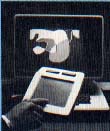
KOALAPAD
Koala Technologies Corp.
4962 El Camino Real, Ste. 125
Los Altos, CA 94022
(415) 964-2992
$125.00, 32K – touch tablet & disk
Reviewed by Clyde Spencer
The graphic powers of the ATARI computers have been advanced again by delivery to market of a long-awaited new peripheral – the KoalaPad touch tablet. It is a small, light unit, about the size and shape of a textbook, that you can use easily in your hands or on a desk top.
The KoalaPad comes with a stylus, instruction manual, and a demonstration graphics program called Micro Illustrator. The tablet itself appears to be well-built. It is housed in an off-white molded plastic case similar in styling to the ATARI 800. KoalaPad plugs into your ATARI through the joystick ports with a standard ATARI controller plug. The active drawing area is 4 1/4" x 4 1/4" for a potential resolution of approximately 0.02 inches per pixel. You can use either your finger or a special stylus to activate the drawing area. It also has two trigger buttons on the top.
It may be used either as a sketch pad for drawing, or in conjunction with removable overlays as a menu controller. It can also be used as a replacement for some applications which use paddles, as long as the paddle triggers are not required.
Micro Illustrator, from Island Graphics, is a drawing package similar to Datasoft’s Micropainter or the software which comes with the Versawriter drawing board system. It allows you to draw, fill with color, magnify, and perform other graphics manipulations.
Micro Illustrator is menu driven, with three sections in the menu. The top section of commands determines the effect accomplished by input from the Koala-Pad drawing surface. Other sections let you adjust the size and shape of "brush," and select the color for draw and fill operations.
There are 14 different drawing commands, and you can save or load picture files to and from disk or cassette. The hue and intensity of any of the four solid colors are variable.
A unique feature of Micro Illustrator is the ability to have one of the colors continuously changing to add movement or animation to the drawing. Another interesting feature, called "mirror," generates a four-fold repetition of anything that you draw, for a kaleidoscopic effect. The program’s procedures are logical and straightforward. Manuals are concise and well written, with few errors.
My only disappointment is that the programmers didn’t find a way to get more than four solid colors on the screen at one time. However, compared to the Apple version, the program offers a much wider palette of colors. The ATARI offers a total palette of colors of 128 hue/luminance combinations to choose from.
KoalaPad’s stylus is made of black plastic, about the size and shape of a pencil, with a conical end tapering to a rounded tip about 0.04" in diameter. It is definitely needed since your finger ’ tends to get tired! Another problem in using your finger is that, because of fatigue and the tendency to lift up when changing direction, the drawing is often left with line gaps.
My review package included a floppy diskette. However, Koala expects to introduce a cartridge version of Micro Illustrator that will run on a 16K ATARI 400. Currently, you need a system with at least 32K RAM and one disk drive.
It is unfortunate that Micro Illustrator will not load graphics files saved by Micropainter or Versawriter.
The incompatibility of Micro Illustrator file formats with existing de facto industry standard graphics files and incompatibility with paddle controller functions are KoalaPad’s most significant drawbacks.
Nevertheless, if you like to do graphics, or want to use touch-activated
menu programs, I believe you will find the KoalaPad touch tablet worth
buying.
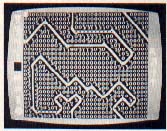
RALLY SPEEDWAY
Adventure International
P.O. Box 3435
Longwood, FL 32750
(800) 323-7172
$49.95, 16K – cartridge
Reviewed by David Duberman
A scrolling car-racing simulation viewed from overhead, Rally Speedway does not attempt to compete with point-of-view arcade racers like Baja Buggies and Pole Position on their own ground. Rally Speedway is a true computer game in that you can alter the program specifications to the point of designing and storing your own 120-screen racing tracks.
The 16K cartridge comes with two large racing tracks, each complete with lovely trackside trees, houses, grass, and water. The full area of a track extends over an area 12 screens wide by 10 screens in height. You can race a friend or try to beat your best time.
Before the race starts, you can set a number of parameters such as road
conditions, acceleration rate, and maximum speed (from 40 to 100 MPH).
As the race takes place, the car (or cars) remains centered on the screen
as the racetrack scrolls along beneath. Your car is controlled with
your joystick, and its brakes with the fire button.
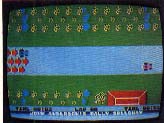
Two methods of steering are available. Normally, you have control over the car from your car’s perspective. That is, push your stick to the left and the car moves to its left, no matter which direction it’s traveling. However, if you press [SELECT] at any time, joystick movement will control the actual direction of the car on the screen. That is, push the stick to the right and the car will move to your right, no matter which way it is moving.
Despite the overhead perspective, the game is actually fun to play. Even with a maximum speed of 60 on dry roads (wet and icy are alternatives), it’s easy to spin out on a curve and crack up into the trees or some poor innocent’s house. When you do, your car bursts into colorful flames. Your driver, who’s burning too, runs out of the car, rolls around on the ground to put out the flames, and then rises and gives a friendly wave to let you know he’s all right. Then you’re set back on the road in the direction you were traveling, ready to go again.
The Make Trax feature is what makes this program special. Choosing from a selection of 20 different types of track sections, you can customize your racetrack layout to your heart’s content. For scenery (and obstacles), you can place different kinds of houses (one with a swimming pool), trees, and lakes wherever you want. Since the track area wraps around, you can create very long, complex racetracks. Also, since it’s possible to crash near any section of track, you can set the direction the car will be facing when it is set on the track after an accident. You can save your custom tracks to disk or cassette.
The ability to customize is what makes this program a must for racing
enthusiasts. If you memorize one track, just create a new one!
Another feature might make Rally Speedway equally attractive to beginners.
Called "Only In A Computer," this option allows you to go anywhere without
crashing!
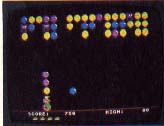
PINHEAD
Utopia Software Inc.
58 Millay Rd.
Morganville, NJ 07751
(201) 536-1191
$29.95, 16K – disk & cassette
Reviewed by David Plotkin
Bally-Midway’s sequel to the fantastically successful Pac-Man, entitled Kick, died an undeserved death in the arcades. Sporting colorful graphics and good play action, it has nevertheless faded into obscurity for reasons unknown. With the release of Pinhead, however, Utopia Software has come to the rescue of ATARI-owning home arcaders. Pinhead is well implemented with good graphics and a superior sound track.
In Pinhead, the player controls a clown mounted on a unicycle. Using a joystick plugged into Port 1, the player guides the clown back and forth along a high wire. Above the clown is a rack of balloons. Periodically, balloons break free from the rack, and your clown must be maneuvered under a falling balloon to pop it on his pointed hat. Missing a balloon causes it to hit the high wire, and the clown to fall to his demise. If the clown does miss the balloon with his hat, he has one chance to recover – hitting the fire button causes the clown’s feet to kick out, rebounding the balloon back into the air for another chance. But be careful – other balloons may be breaking loose meanwhile! The balloons in the rack fall at different speeds, with blue being the fastest and the most difficult to catch.
After the first screen is cleared, things get more complicated. In the higher screens, balloons are caught on the pointed hat and will stack up four high before all of them pop and you start catching the next batch. Catching a blue balloon on the top of this stack can be quite a feat! Also present in the rack are little monsters. Catching one of them gets you a bonus, and the little monster will eat all the stacked balloons. But from then on, you must catch balloons and/or other monsters on top of the monsters you’ve already caught, so it gets more difficult. Also complicating matters are bombs, which must be avoided altogether, and buckets, which can be caught but not kicked.
The peripheral aspects of Pinhead are quite well done – there are cute intermissions, where Pac-Man makes an appearance, and superb three-channel music. A different tune accompanies each screen. The animation is very well done. The clown pedals his unicycle realistically, and even looks up at the balloons by tilting his head.
Pinhead has an initially high frustration factor because it is difficult to control the clown with the pinpoint accuracy required. Continued play quickly leads to improved scores, however, so this game should be given a chance to prove itself.
Pinhead is unusual, well done, and exceptionally challenging. It is a worthwhile addition to your game collection.